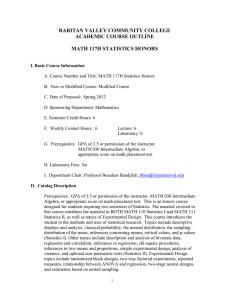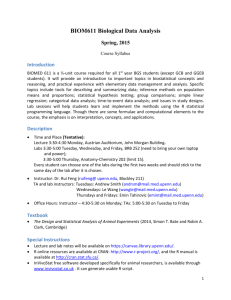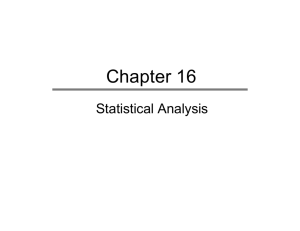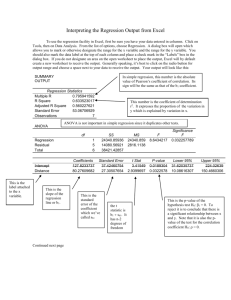Link to Syllabus - Elon University
advertisement
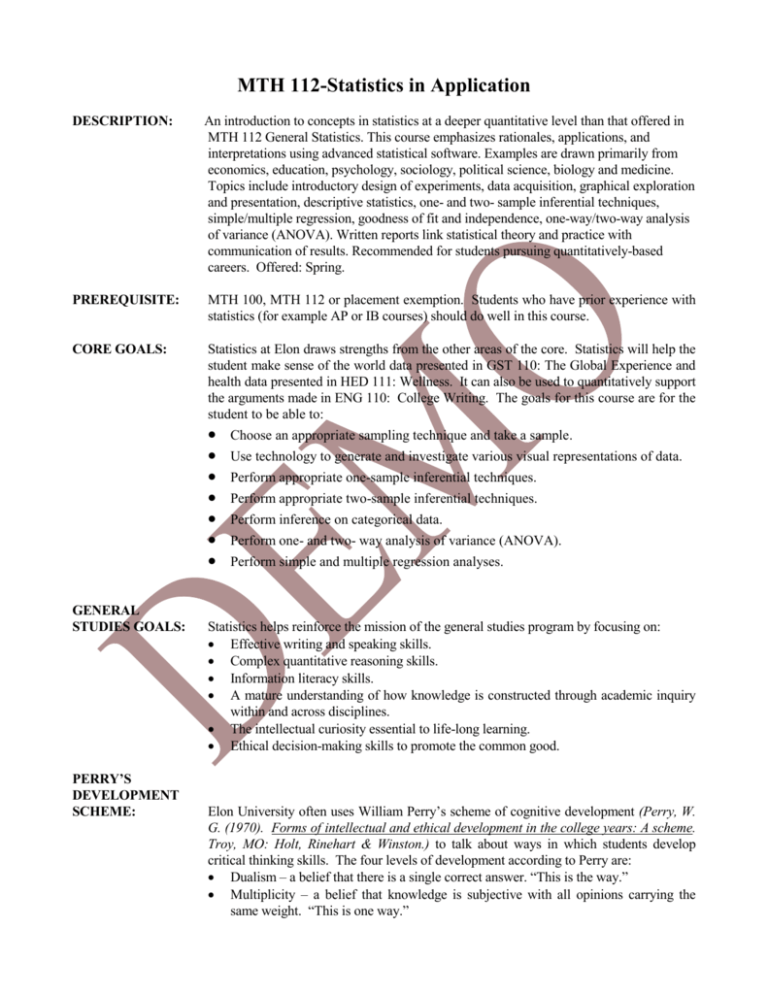
MTH 112-Statistics in Application DESCRIPTION: An introduction to concepts in statistics at a deeper quantitative level than that offered in MTH 112 General Statistics. This course emphasizes rationales, applications, and interpretations using advanced statistical software. Examples are drawn primarily from economics, education, psychology, sociology, political science, biology and medicine. Topics include introductory design of experiments, data acquisition, graphical exploration and presentation, descriptive statistics, one- and two- sample inferential techniques, simple/multiple regression, goodness of fit and independence, one-way/two-way analysis of variance (ANOVA). Written reports link statistical theory and practice with communication of results. Recommended for students pursuing quantitatively-based careers. Offered: Spring. PREREQUISITE: MTH 100, MTH 112 or placement exemption. Students who have prior experience with statistics (for example AP or IB courses) should do well in this course. CORE GOALS: Statistics at Elon draws strengths from the other areas of the core. Statistics will help the student make sense of the world data presented in GST 110: The Global Experience and health data presented in HED 111: Wellness. It can also be used to quantitatively support the arguments made in ENG 110: College Writing. The goals for this course are for the student to be able to: GENERAL STUDIES GOALS: PERRY’S DEVELOPMENT SCHEME: Choose an appropriate sampling technique and take a sample. Use technology to generate and investigate various visual representations of data. Perform appropriate one-sample inferential techniques. Perform appropriate two-sample inferential techniques. Perform inference on categorical data. Perform one- and two- way analysis of variance (ANOVA). Perform simple and multiple regression analyses. Statistics helps reinforce the mission of the general studies program by focusing on: Effective writing and speaking skills. Complex quantitative reasoning skills. Information literacy skills. A mature understanding of how knowledge is constructed through academic inquiry within and across disciplines. The intellectual curiosity essential to life-long learning. Ethical decision-making skills to promote the common good. Elon University often uses William Perry’s scheme of cognitive development (Perry, W. G. (1970). Forms of intellectual and ethical development in the college years: A scheme. Troy, MO: Holt, Rinehart & Winston.) to talk about ways in which students develop critical thinking skills. The four levels of development according to Perry are: Dualism – a belief that there is a single correct answer. “This is the way.” Multiplicity – a belief that knowledge is subjective with all opinions carrying the same weight. “This is one way.” 2 Relativism – an external set of criteria are used to judge the strength of various views. “This is the best way because . . . ” Commitment – an acceptance that there is frequently no certainty in real-life questions, yet choices must be made and one must commit to particular ideas and opinions. “This is MY way because . . .” Statistics strives to provide multiple ways to view, represent, and use data while offering criteria for placing multiple views in a reasoned perspective. OUTCOMES: Statistics promotes quantitative critical thinking skills that should serve the student in the rest of their course of studies at Elon. Specific outcomes that should prove valuable include the ability to: OBJECTIVES: Understand the basic concepts in data production. Develop an ability to evaluate the quality of data. Learn the techniques of data analysis and statistical inference. Gain an appreciation for the role data can play in improving our understanding of the world. Be able to intelligently discuss media reports that involve statistical issues. Improve in the communication of quantitative ideas, both in writing and in speech. A list of specific objectives follows each area of the content. After studying sampling techniques, the student will be able to: Distinguish between various sampling techniques. Obtain a simple random, stratified, systematic and cluster sample. Discuss the pitfalls of convenience sampling. After studying introductory design of experiments, the student will be able to: Define designed experiment. Understand the steps in designing an experiment. Understand the completely randomized, matched-pairs and randomized block designs. After graphical exploration and presentation of data, the student will be able to: Generate and read various visual displays of quantitative and qualitative data including bar graphs and/or histograms using technology. Recognize the four basic data distribution shapes: uniform, normal/bell-shaped, skewed left and skewed right. Recognize patterns/trends in data. After discovering various statistical measures/descriptives, the student will be able to: Compare and contrast statistical measures and their properties. Compare data from different distributions. Check a data set for outliers. Construct and interpret box-plots. After one-sample inferential techniques, the student will be able to: Describe the overall idea behind a sampling distribution. Describe the overall idea behind inferential statistics. 3 Construct and interpret confidence intervals about the population mean (large and small sample), proportion and variance/standard deviation, with an emphasis on technology. Use a confidence interval to test a claim about a parameter (without setting up the whole hypothesis testing structure). Set up and perform an appropriate test of significance about a population mean, proportion and standard deviation using the classical and P-value methods. Emphasis on technology. Compute the power of a test. After two-sample inferential techniques, the student will be able to: Distinguish between dependent and independent sampling. Construct confidence intervals and perform significance tests for claims regarding the difference of two independent or dependent means with an emphasis on technology. Construct confidence intervals and perform significance tests for claims regarding two proportions with an emphasis on technology. Test claims regarding two population standard deviations. Following the section on inference on categorical data, the student will be able to: Read contingency tables. Use technology to perform goodness of fit tests, tests for independence and homogeneity of proportions. After the sections on One- and two- way ANOVA, the student will be able to: Verify the requirements to perform an ANOVA. Test a claim regarding three or more means using ANOVA tables generated using technology. Perform Tukey’s test for multiple comparisons using technology. Following the section on simple regression, the student will be able to: Generate and read a scatter plot obtained using technology. Interpret a correlation coefficient and coefficient of determination. Obtain the least-squares regression line and interpret the coefficients. Use technology to generate the statistics and graphs needed to test the significance of the least-squares regression model. Perform residual analysis on a regression model including verifying the normality of residuals. Use the least squares line to make predictions. Construct prediction intervals for an individual response. After the section on multiple regression, the student will be able to: Use technology to obtain a multiple regression equation. Interpret the coefficients of a multiple regression equation. Use technology to generate the statistics and graphs needed to test the significance of the regression coefficients and overall fit. Build a regression model using various techniques such as backward or forward selection.
